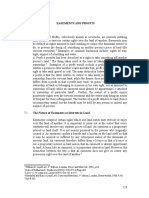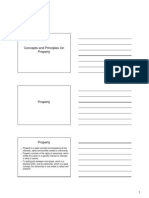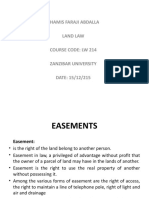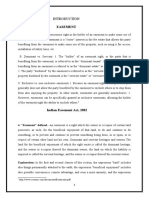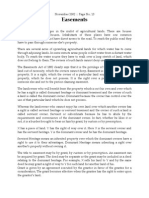0 ratings0% found this document useful (0 votes)
43 viewsFee Simple Estate Is The Highest Estate or Absolute Right in Real Property
This document provides an overview of different types of property ownership, rights, and limitations. It discusses various estates of ownership like fee simple and leasehold estates. It also covers concurrent ownership types like joint tenancy and tenants in common. Different ownership alternatives are described such as condominiums, co-operatives, fractional ownership, and co-ownership. The document also discusses easements, different types of easements, restrictive covenants, encroachments, adverse possession, and profit-à-prendre. It provides details on the definition and characteristics of these concepts as well as how they are created and can be terminated.
Uploaded by
SylviaCopyright
© © All Rights Reserved
Available Formats
Download as DOCX, PDF, TXT or read online on Scribd
0 ratings0% found this document useful (0 votes)
43 viewsFee Simple Estate Is The Highest Estate or Absolute Right in Real Property
This document provides an overview of different types of property ownership, rights, and limitations. It discusses various estates of ownership like fee simple and leasehold estates. It also covers concurrent ownership types like joint tenancy and tenants in common. Different ownership alternatives are described such as condominiums, co-operatives, fractional ownership, and co-ownership. The document also discusses easements, different types of easements, restrictive covenants, encroachments, adverse possession, and profit-à-prendre. It provides details on the definition and characteristics of these concepts as well as how they are created and can be terminated.
Uploaded by
SylviaCopyright
© © All Rights Reserved
Available Formats
Download as DOCX, PDF, TXT or read online on Scribd
You are on page 1/ 6
Module 3: Introducing Property Ownership, Rights, and Limitations
Lesson 1: Introduction to Ownership
Estate interest An estate is in interest in land or more Riparian
specifically the degree, quantity, nature, and right:
extent of interest that a person has in a water
property.
Fee simple estate is the highest estate or
absolute right in real property. The holder of
such a fee simple estate has the most rights
and fewest limitations, and can use, sell,
lease, enter, or give away the property, or
refrain from any of these rights.
A leasehold estate is an interest in land for a
definite period of time (i.e. a week, a month, a
year, 99 years, or any other specific period of
time).
Concurrent ownership Concurrent ownership is defined as
two or more persons having the right of
ownership at the same time.
Concurrent interests normally fall
into two primary categories: joint tenancy
and tenants in common.
Joint tenancy involves ownership of
land by two or more persons. Joint
tenancy requires the presence of four
unities, which are title, time, possession,
and interest(PITT). Joint tenancy also has
the right of survivorship.
Tenants in common involves
concurrent ownership of land by two or
more persons. The only unity in tenants in
common is possession and there is no
right of survivorship.
Ownership alternatives A condominium is a form of ownership where
there is a fee simple ownership of the unit and a
tenant in common ownership of the portion used
jointly with others known as the common
elements.
A common elements condominium (CEC)
corporation consists only of common elements
such as roads, parking lots, a golf course, a ski hill,
or a community centre.
The owner’s property is “tied” to the CEC that is
referred to as a Parcel of Tied Land (“POTL”).
An equity co-operative is a corporation that owns
the land and buildings, with members as
shareholders in the corporation. Ownership is by
way of a share certificate, in combination with an
occupancy agreement relating to a specific unit
and often parking and locker.
A non-profit housing co-operative is without
shares and has the primary objective of providing
housing for its members.
Fractional ownership is shared ownership that
allows an individual to partially own a valuable
asset without putting up the money to purchase
the whole asset outright. Fractional ownership
allows multiple buyers to obtain part of a property
title as tenants in common with usage rights
allocated depending on the size of the fraction
purchased.
Co-ownership applies to any situation in which
two or more persons own property jointly, be it
two individuals owning a home, four family
members owning a recreational property, or 10
investors owning a plot of land. It is a tenant in
common ownership alternative, in which the deed
outlines the proportionate interest in property
held by each owner.
A land lease gives the exclusive right to use the
land for the time the lease is active but does not
give ownership of the land. In a life lease, the
person does not own a property but an “interest”
in that property in exchange for a lump sum
payment up-front. The person also pays monthly
maintenance fees that include a range of
expenses, including snow removal, landscaping,
garbage disposal, repairs, building insurance, and
possibly meals
Timeshare, trailers, and Timeshare is the division of property rights into
house boat fractional interests based on time. Timeshare
ownerships, and interests can be acquired via two methods: Fee
requirements of a ownership interest or right-touse interest. Have
salesperson if trading 10 days cooling period If the buyer hasn’t received
in these types of a copy of the written agreement during the one-
property description year period, he can cancel the agreement.
A mobile home is a transportable, prefabricated
structure that is situated in one particular place
and used as permanent living accommodation.
Houseboats are a form of ownership wherein the
property is a boat used or converted into a
dwelling. This ownership type is unique, as there is
no “land” in question.
Mobile home parks and rented mobile homes are
covered by the provisions the Residential
Tenancies Act, 2006.
Lesson 2: Ownership Rights and Limitations
Easements: definition, Even the highest estate or absolute right in
characteristics , property is subject to some restrictions and
creation, and limitations, both private and government,
termination imposed by laws of governing authorities.
• An easement is a right enjoyed by one
landowner over the land of another and is granted
for a special purpose rather than for general use
and occupation of the land. An easement has six
defining characteristics:
o It must be granted for a clear and specific use. o
It must be comprised of both dominant and
servient tenements.
o It must have separate ownership of the lands
involved.
o It must solely benefit the dominant tenement.
o It runs with the land, so it binds subsequent
owners.
o The dominant and servient tenement do not
have to be adjoining.
• A dominant tenement is defined as the estate or
interest in land that derives benefit from an
easement over a servient tenement, as in a right-
of-way. An easement must confer a benefit on the
dominant tenement.
• A servient tenement involves land over which an
easement exists in favour of a dominant
tenement.
• An easement can be created in one of four ways:
express grant, prescription, implication, or statute.
• An easement can be terminated in one of three
ways: merge, release, or ceasing of purpose.
Type of easement There are several types of easements commonly
found in residential properties:
• A right-of-way is a frequently encountered form
of easement that allows a person to travel or pass
through another person’s land.
• Party wall easements are created when
registered owners of adjoining parcels of land
enter into a party wall agreement in regard to the
dividing wall between the attached units.
• A mutual shared driveway occurs when a strip of
land shared by adjoining neighbours is used as a
joint driveway by both parties and creates an
easement on each property.
Restrictive covenant, A restrictive covenant is a type of contractual Zoning
encroachment, adverse arrangement that places restrictions on what the restrictive
possession, and profit- owner of the land can do with their property. A 不需要登
à-prendre restrictive covenant is a legally binding obligation 记 在 title
written into the deed of a property and is 上。
registered on title. Restrictive covenants run with
the land. Therefore, a buyer who purchases a
property with a restrictive covenant on title must
honour these restrictions.
An encroachment is a situation that arises when a
property owner violates the property rights of
their neighbour by building a structure wholly or
partially on the neighbouring property.
Adverse possession occurs when an individual
who is not the owner takes possession of the
property, hostile to and without the consent of the
owner. It is possible, by adverse possession, for an
occupier of land to extinguish the title of the
owner. The possessor then becomes, in effect, the
owner of the land.
For adverse possession to exist, the possession
must be: • Open • Exclusive • Continuous for a
period • Without the consent of the owner, but •
With the owner’s knowledge
No title claims by adverse possession can occur
under the land titles, which is a system of land
registration in Ontario.
The term profit-à-prendre means “right of taking”.
It involves the right to enter upon a property
based on a written agreement and take something
from it. It is a non-possessory interest in land that
is similar to an easement, but it specifically grants
the holder only the right to take natural resources
such as crops, oil, minerals, timber, and wild game
from the land of another. This right can, in some
instances, pass with title upon the sale of the
property.
Other government Expropriation involves the acquisition of private
limitations to property property by the government for the public’s best
ownership: interest and use with fair compensation to the
expropriation, the right owner. There is a process in place to permit a
to regulate and levy landowner to object to the expropriation and/or
taxes, and escheat the amount of compensation being offered.
Other government limitations imposed upon
property ownership include the right to regulate
and the right to levy taxes. Right to regulate is the
right of government to regulate property for the
promotion of public safety, health, morals, and
general welfare. It is also referred to as police
power. Right to levy taxes is the right of the
government to levy taxes on property.
Escheat is the reversion of property to the
government, or some kind of government agency,
in the event that a property owner dies leaving no
will and having no legally qualified heir to whom
the property may pass.
You might also like
- Introduction To Real Property Law: General Aspects of PropertyNo ratings yetIntroduction To Real Property Law: General Aspects of Property17 pages
- Prepared By: Mari Dece Creche P. Biscocho BS in Real Estate ManagementNo ratings yetPrepared By: Mari Dece Creche P. Biscocho BS in Real Estate Management6 pages
- Real Property Ownerships Possessory InterestsNo ratings yetReal Property Ownerships Possessory Interests7 pages
- Land Law: Session Three Easements, Profits and MortgagesNo ratings yetLand Law: Session Three Easements, Profits and Mortgages39 pages
- Property, in The Abstract, Is What BelongsNo ratings yetProperty, in The Abstract, Is What Belongs12 pages
- Legal Fundamentals For Canadian Business Canadian 4th Edition Yates Solutions Manual100% (39)Legal Fundamentals For Canadian Business Canadian 4th Edition Yates Solutions Manual22 pages
- Topic 7 – Easements and profits à prendre UGLaws VLENo ratings yetTopic 7 – Easements and profits à prendre UGLaws VLE27 pages
- Khamis Faraji Abdalla Land Law Course Code: LW 214 Zanzibar University DATE: 15/12/215100% (1)Khamis Faraji Abdalla Land Law Course Code: LW 214 Zanzibar University DATE: 15/12/21526 pages
- Easement: 4. "Easement" Defined.-An Easement Is A Right Which The Owner or Occupier of Certain LandNo ratings yetEasement: 4. "Easement" Defined.-An Easement Is A Right Which The Owner or Occupier of Certain Land10 pages
- Lect. 5 Easements - Characteristics and AquisitionNo ratings yetLect. 5 Easements - Characteristics and Aquisition25 pages
- Real Estate Terminology: Property Management, Financing, Construction, Agents and Brokers TermsFrom EverandReal Estate Terminology: Property Management, Financing, Construction, Agents and Brokers TermsNo ratings yet
- Mananquil v. Villegas Guy v. CA Chin Ah Foo v. ConcepcionNo ratings yetMananquil v. Villegas Guy v. CA Chin Ah Foo v. Concepcion5 pages
- Types of Companies On The Basis of Formation or IncorporationNo ratings yetTypes of Companies On The Basis of Formation or Incorporation3 pages
- Agreement For Educational Cooperation Between - and The University of Granada For The Organisation of Student Internships inNo ratings yetAgreement For Educational Cooperation Between - and The University of Granada For The Organisation of Student Internships in5 pages
- S Muruganandam V J Joseph Connected Matters 2022 Livelaw Mad 63watermark 409760No ratings yetS Muruganandam V J Joseph Connected Matters 2022 Livelaw Mad 63watermark 40976046 pages
- 665eb6096eb6f40018ac2c4f - ## - E-Notes - The Indian Partnership Act and LLP ActNo ratings yet665eb6096eb6f40018ac2c4f - ## - E-Notes - The Indian Partnership Act and LLP Act66 pages
- Alabama Great Southern Rail Road Co. v. CarrollNo ratings yetAlabama Great Southern Rail Road Co. v. Carroll13 pages
- Guarantee Indemnity and Statement of Networth (Updated 2023)No ratings yetGuarantee Indemnity and Statement of Networth (Updated 2023)6 pages
- Great Peace Shipping LTD V Tsavliris Salvage (International) LTDNo ratings yetGreat Peace Shipping LTD V Tsavliris Salvage (International) LTD49 pages
- Villaflor vs. Juico (G.R. No. L-15737 February 28, 1962)No ratings yetVillaflor vs. Juico (G.R. No. L-15737 February 28, 1962)1 page
- Form MBP - 1: Notice of Interest by DirectorNo ratings yetForm MBP - 1: Notice of Interest by Director1 page
- Affidavit of Heirship Acknowledgment of CheckNo ratings yetAffidavit of Heirship Acknowledgment of Check1 page
- Introduction To Real Property Law: General Aspects of PropertyIntroduction To Real Property Law: General Aspects of Property
- Prepared By: Mari Dece Creche P. Biscocho BS in Real Estate ManagementPrepared By: Mari Dece Creche P. Biscocho BS in Real Estate Management
- Land Law: Session Three Easements, Profits and MortgagesLand Law: Session Three Easements, Profits and Mortgages
- Legal Fundamentals For Canadian Business Canadian 4th Edition Yates Solutions ManualLegal Fundamentals For Canadian Business Canadian 4th Edition Yates Solutions Manual
- Topic 7 – Easements and profits à prendre UGLaws VLETopic 7 – Easements and profits à prendre UGLaws VLE
- Khamis Faraji Abdalla Land Law Course Code: LW 214 Zanzibar University DATE: 15/12/215Khamis Faraji Abdalla Land Law Course Code: LW 214 Zanzibar University DATE: 15/12/215
- Easement: 4. "Easement" Defined.-An Easement Is A Right Which The Owner or Occupier of Certain LandEasement: 4. "Easement" Defined.-An Easement Is A Right Which The Owner or Occupier of Certain Land
- Lect. 5 Easements - Characteristics and AquisitionLect. 5 Easements - Characteristics and Aquisition
- Real Estate Terminology: Property Management, Financing, Construction, Agents and Brokers TermsFrom EverandReal Estate Terminology: Property Management, Financing, Construction, Agents and Brokers Terms
- Fostering Harmony in Sectional Title EstatesFrom EverandFostering Harmony in Sectional Title Estates
- Mananquil v. Villegas Guy v. CA Chin Ah Foo v. ConcepcionMananquil v. Villegas Guy v. CA Chin Ah Foo v. Concepcion
- Types of Companies On The Basis of Formation or IncorporationTypes of Companies On The Basis of Formation or Incorporation
- Agreement For Educational Cooperation Between - and The University of Granada For The Organisation of Student Internships inAgreement For Educational Cooperation Between - and The University of Granada For The Organisation of Student Internships in
- S Muruganandam V J Joseph Connected Matters 2022 Livelaw Mad 63watermark 409760S Muruganandam V J Joseph Connected Matters 2022 Livelaw Mad 63watermark 409760
- 665eb6096eb6f40018ac2c4f - ## - E-Notes - The Indian Partnership Act and LLP Act665eb6096eb6f40018ac2c4f - ## - E-Notes - The Indian Partnership Act and LLP Act
- Guarantee Indemnity and Statement of Networth (Updated 2023)Guarantee Indemnity and Statement of Networth (Updated 2023)
- Great Peace Shipping LTD V Tsavliris Salvage (International) LTDGreat Peace Shipping LTD V Tsavliris Salvage (International) LTD
- Villaflor vs. Juico (G.R. No. L-15737 February 28, 1962)Villaflor vs. Juico (G.R. No. L-15737 February 28, 1962)






